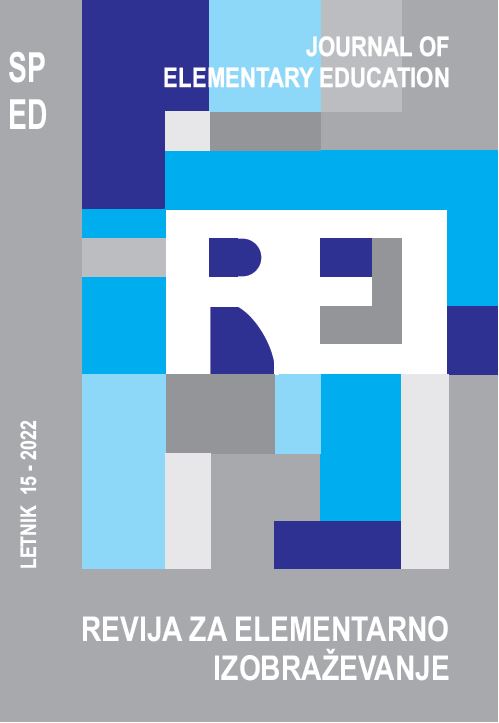The Method of Aesthetic Transfer as a Didacticprinciple in Museum Pedagogy
DOI:
https://doi.org/10.18690/rei.15.Spec.Iss.93-114.2022Keywords:
Method of aesthetic transfer, art appreciation, museum pedagogy, gallery, elementary schoolAbstract
Previous research has shown that the method of aesthetic transfer works successfully in preschool as well as in primary and secondary education when it comes to regular forms of teaching. In this study, we were interested in how this principle can be implemented in museum education in an authentic gallery space. To this end, a case study was conducted with a sample of 55 students aged 12-14 (n = 55). The method of aesthetic transfer was tested on 4 works in the Maribor Art Gallery. The results show that the method of aesthetic transfer proved to be a successful didactic principle even in the gallery space, especially as a successful principle for learning about contemporary visual art.
Downloads
References
Clarkin-Phillips, J., Carr, M., Thomas, R., Tinning, A., and Waitai, M. (2018). Fostering the Artistic and Imaginative Capacities of Young Children: Case Study Report from a Visit to a Museum. IJEC 50, 33-46. https://doi.org/10.1007/s13158-018-0211-2
Duh, M (2013). Die Kommunikationsebene des Kunstwerkes in der Funktion Der Entwicklung der Kunstbetrachtung. In: Janikova, V., Seebauer, R. (eds.). Education and Languages in Europe, 65–74.
Duh, M. (2014). Razvijanje likovne apreciacije s srednješolci. Pedagoška obzorja: časopis za didaktiko in metodiko, 29(1), 60–75.
Duh, M. (2015). The Function of Museum Pedagogy in the Development of Artistic Appreciation. Journal of Elementary Education, 8(4), 87–101.
Duh, M., Herzog, J., and Zupančič, B. (2014). Some aspects of the developing art appreciation. In Bunčić, V. (ed.). New Horizons in Education, Culture and Sports: [collected papers] 6th International Interdisciplinary Scientific Professional Conference, Serbia, Subotica, 94–96.
Duh, M., and Pavlič, A (2015): Gallery-pedagogical activities and fine arts in the first three years of primary school. Innovative Issues and Approaches in Social Sciences, 8(2), 25–47.
Duh, M., and Zupančič, T. (2011). The method of aesthetic transfer: An outline of a specific method of visual arts didactics. Croatian Journal of Education, 13(1), 42–75.
Duh, M., and Zupančič, T. (2013). Likovna apreciacija in metoda estetskega transferja. Revija za elementarno izobraževanje / Journal of Elementary Education, 6(4), 71–86.
Hackett, A. (2014) Zigging and zooming all over the place: Young children's meaning making and movement in the museum.’ Journal of Early Childhood Literacy, 14(1), 5–27.
Hardman, C. (2001) ‘Can there be an anthropology of children?’ Childhood, 8(4), 501–517.
Henschel, A. (2012) Der Begriff der Vermittlung im Rahmen von Kunst. In: Prinz-Kiesbuye, Myrna-Alice, Schmidt, Yvonne and Strickler, Pia (Eds.): Theater und Öffentlichkeit. Theatervermittlung als Problem, Zurich, S, 17–27.
Krebber, G. (2020). Kollaboration in der Kunstpädagogik. Munich: Kopaed.
Kunz-Ott, H. (2007). Schule und Museum – Zum Bildungsauftrag der Museen. In Wagner E., Dreykorn, M. (eds.). Schule Bildung Museum. Munich: Kopaed, 19–20.
Otto, G. (2007) Schule und Museum – Unterschiede und Gemeinsamkeiten an zwei Lernorten. In Wagner E., and Dreykorn, M. (eds.). Schule Bildung Museum. Munich: Kopaed, 15–18.
Rogoff, I (2002). Wir. Kollektivität, Mutualitäten, Partizipationen. In Von Hantelmann, A. D., Jongbloed, M. (eds.) I promise It's political. Performativitat in der Kunst. Koln, 52–60.
Schütz, H. G. (2002). Kunst und Analyse der Betrachtung. Entwicklung und Gegenwart der Kunstrezeption zwischen Original und Medien. Hohengehren: Schneider Verlag.
Tavčar, L. (2009). Homo Spectator. Introduction to museum pedagogy. (digital booklet). Ljubljana, Pedagogical Institute. Accessed 06. 12. 2021 http://www.sistory.si/publikacije/
Tripps, M. (1990). Was ist Museumspädagogik? In: Schmeer-Sturm, M., L., Thinesse-Demel, J. Ulbricht, K., and Vieregg, H. (Eds.): Museumspädagogik. Grundlagen und Praxisbericht (3–5). Baltmannsweiler: Schneider.
Uhlig, B. (2004). Kunstrezeptionmit Kindern. In: Kunst+Unterrricht, H 288: 4 - 13. Friedrich Verlag GmbH.
Vogel, B. (2007). Arbeitsfelder und Planungskriterien für Museumsangebote. In Wagner E., Dreykorn, M. (eds.). Schule Bildung Museum. Munich: Kopaed, 53–54.
Wagner, E. (2007). Museen und Schule - warum sie füreinander interessant sind. In Wagner E., Dreykorn, M. (eds.). Schule Bildung Museum, 13–14.
Zupančič, T., and Duh, M. (2009). Pablo Picasso's fine arts and craftsmanship. Art and pedagogical project in kindergarten Opatija. Rijeka.
Downloads
Published
Issue
Section
License
Copyright (c) 2022 Katja Kozjek Varl, Matjaž Duh, Jerneja Herzog

This work is licensed under a Creative Commons Attribution 4.0 International License.
